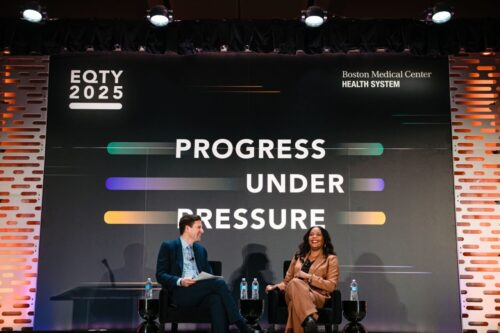Telehealth: Bridging Gaps in Care or Perpetuating Health Inequities?
April 28, 2022

PeoplesImages, Getty Images
New research shows Telehealth has become a "double-edged sword" when it comes to health equity and access to technology.
When much of the world shut down in March of 2020 due to the COVID-19 pandemic, hospitals, and healthcare providers made a huge shift in how they delivered healthcare almost overnight — from in-person care to telehealth.
During the pandemic, the use of telehealth increased 300-fold, with about 50% of all adult visits moving to the virtual space. And while many may see telehealth as an opportunity to increase healthcare access and reduce health inequities, telehealth also presents an access challenge for lower-income adults, many of whom don’t have the means to afford digital access or the tools to allow them to effectively engage in the digital world.
According to researchers from Boston Medical Center (BMC), Boston University Questrom School of Business, and Boston University School of Medicine (BUSM), this contradiction may have inadvertently turned telehealth into a “double-edged sword,” in that the technology that holds the potential to reduce health inequities for people of color, immigrants, and low-income communities may instead intensify existing structural inequities.
“Using qualitative data and our own experiences as front-line primary care physicians we discovered that having access to digital technology is not sufficient in redressing healthcare inequities,” says corresponding author Rebecca Mishuris, MD, MPH, primary care physician at BMC and chief medical information officer of the BMC Health System. “Patients also need to know how to effectively engage with that technology, and patients also need advocacy, either the capacity for self-advocacy or a system around them that can advocate on their behalf. Telehealth has a huge potential to maybe reduce health inequities, but if we don’t pay attention to it, we could actually make those inequities worse.”
To learn more about their research on telehealth, HealthCity spoke with Mishuris, Katherine Gergen Barnett, MD, vice chair of primary care innovation and transformation at BMC, and Jayakanth Srinivasan, PhD, research associate professor at Boston University’s Questrom School of Business.
HealthCity: What barriers are patients facing in accessing telehealth?
Rebecca Mishuris, MD, MPH: A key component of these structural inequities is the digital divide, driven partly by “digital redlining.” This is the 20th century manifestation of the redlining that occurred in the 1930s, which today has resulted in serious differentials in life expectancy, educational attainment, and income. It has also led to a disparity in access to digital tools.
For example, one way it has manifested is in broadband access; in certain urban neighborhoods, bandwidth is slower than other neighborhoods. It also manifests in people not having the education and exposure to digital tools that allows them to effectively engage in the digital world. And these days, you need to be able to engage in the digital world to be an active and successful member of society. For this reason, I have started to think of digital access as a social determinant of health (SDoH).
Two other barriers we identified are digital fluency, which is the ability to effectively engage with the technology, and a capacity for health advocacy.
Jayakanth Srinivasan, PhD: There’s been so much information around telehealth in terms of creating the infrastructure, but even when you have the infrastructure, if people don’t know how to use the technology, it doesn’t help. So, that’s why we say although infrastructure is necessary, it is not sufficient for enabling access. You also need digital fluency, which is not just having the phone, but knowing how to use the phone and its features.
For example, providers told us that many of their patients preferred not to use video because they didn’t know how to do a virtual background, and they had six other people in the house, or their house was messy and they were embarrassed. Digital fluency is so much more than just having a phone, but also understanding all its features.
In terms of health advocacy, this means whether patients can advocate for their own care. We often assume that patients know how to do this, but this is not the case for many in vulnerable populations. And when you add telehealth to this equation, you’re adding another layer that makes it even more challenging to navigate. Patients are no longer in their community health center, in a familiar room where they feel comfortable talking in person with their physician, but they are thrust into this new digital forum. These are some of the reasons why it’s not sufficient just to look at infrastructure gaps in communities that have historically been redlined.
HC: Do you know what patient populations are being left behind?
RM: We learned that about 85% of our patients have digital access, which is higher than we would have expected. And while we found there was no difference by race in who said they have access, the number who scheduled their telehealth visits by video differed by race. While 67% of white patients opted to schedule their telehealth visits by video, only 60% of our Black and Latinx patients did.
While all groups had fewer telehealth visits completed by video than scheduled, we also saw a difference in these numbers by race. About 47% of white patients completed their virtual visits by video, while only 40% of our Black and Latinx patients did. The rest ended up doing a phone call visit instead.
Katherine Gergen Barnett: In practice, I have found that my patients who are elderly or speak English as a second language are less likely to have a video call. While a phone call offers some connection with the patient, it doesn’t approximate a telehealth visit, where you are seeing their face and eyes and skin. You can’t get the same type of information about how the patient is doing. That’s actually been one of the advantages of telehealth — you often get a window into a patient’s day-to-day life that helps you form a more complete picture of them, so you can then take better care of them. That is also lost on a telephone call.
HC: What steps has BMC taken to help reduce barriers to telehealth?
RM: We’ve done two things. On a local level, we have started to treat digital access as a social determinant of health. Patients who are scheduling a telehealth visit are asked if they have a device with a microphone and a camera and if it’s connected to the internet. We’re also starting to connect those patients to affordable devices and classes in the community.
My role at BMC is to make sure we choose a digital platform that supports the workflow needs, is easy for both patients and providers to use, has instructions available in many languages, and that allows us to have other clinicians and staff, including interpreters, drop in when we need them. For example, we bring in a scheduler at the end of the visit, so the provider can drop off and scheduler stays on and schedules the next visit.
KGB: BMC also has an important seat at the table in terms of state-wide policy. I’m on the health equity policy committee and we’re looking at bills and motions coming out related to technological access and thinking about how we are putting our stake in the ground to get everyone in our community on the internet, and how we support internet literacy for those in our community who aren’t getting access now.
HC: What steps can healthcare providers and hospitals take to ensure telehealth reduces health inequities rather than exacerbating them?
RM: Telehealth is here to stay, but it should not be just a provider and patient on video screen. So, the first step is to choose a telehealth platform that supports multi-party visits and that allows for interpreters and other staff to engage directly through the video platform. We will make no inroads into equity without that.
When we moved overnight to telehealth, we suddenly stripped away all the other interactions in a typical healthcare setting, and you were missing the medical assistant, social worker, front desk person, phlebotomist, and nurse, and with them, all those opportunities for patients to ask for what they need.
The switch to telehealth happened so fast, but we really need to take a moment to step back and build that type of holistic delivery model into the virtual space. If we don’t do that, we will leave a segment of the population that is already left behind even more so, and that’s where concept of double-edged sword comes from.
KGB: As healthcare providers, we all need to continue to listen to our patients about what their experiences are, find out what’s helping and hindering them, and learn how we can be their advocates in improving care. We’re all so busy at BMC plugging the holes, we don’t always look up to see where we could be. But we have a unique opportunity with telehealth because we are still creating it, so we have the chance to build it to best suit our patients’ needs and use it to create less healthcare inequity.
JS: One of the bright points in telehealth has been the extent of transformation in behavioral health. We have always struggled with access to mental health, but the move to telehealth marked the first time that no-show rates actually dropped. I think this was because we created a modality of care that was convenient and less stigmatizing for a lot of people. We moved care to point of need in a way that’s accessible and easy.
So, I would recommend when people talk about telehealth, they think about what is the modality to which we move care to point of need. In some cases, it’s about physically moving the facility, and in some cases, it’s about virtually creating that care, while knowing the limits of what that technology can help you with. We moved care to point of need very effectively for behavioral healthcare. With primary care and a lot of other types of medical care, we are still evolving our understanding of how the patient/provider relationship changes when you move to telehealth.


